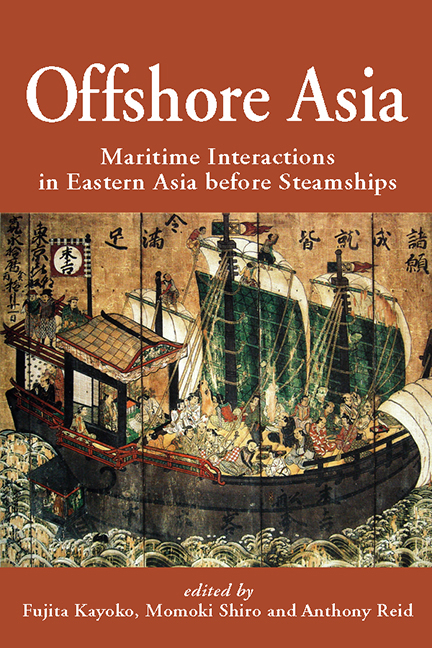Book contents
- Frontmatter
- Contents
- Maps
- Tables and Figures
- Preface
- Contributors
- Map 1 Eastern Asia in the 13th–16th Centuries
- 1 Introduction: Maritime Interactions in Eastern Asia
- 2 The Periodization of Southeast Asian History, in Comparison with that of Northeast Asia
- 3 Merchants, Envoys, Brokers and Pirates: Hokkien Connections in Pre-modern Maritime Asia
- 4 An Asian Commercial Ecumene, 900–1300 ce
- 5 The Japanese Archipelago and Maritime Asia from the 9th to the 14th Centuries
- 6 Saltpetre Trade and Warfare in Early Modern Asia
- 7 Shaping Maritime East Asia in the 15th and 16th Centuries through Choson Korea
- 8 Shipwreck Salvage and Survivors’ Repatriation Networks of the East Asian Rim in the Qing Dynasty
- 9 Wei Zhiyan and the Subversion of the Sakoku
- 10 Metal Exports and Textile Imports of Tokugawa Japan in the 17th Century: The South Asian Connection
- Bibliography of Works Cited
- Index
- NALANDA-SRIWIJAYA SERIES
10 - Metal Exports and Textile Imports of Tokugawa Japan in the 17th Century: The South Asian Connection
Published online by Cambridge University Press: 21 October 2015
- Frontmatter
- Contents
- Maps
- Tables and Figures
- Preface
- Contributors
- Map 1 Eastern Asia in the 13th–16th Centuries
- 1 Introduction: Maritime Interactions in Eastern Asia
- 2 The Periodization of Southeast Asian History, in Comparison with that of Northeast Asia
- 3 Merchants, Envoys, Brokers and Pirates: Hokkien Connections in Pre-modern Maritime Asia
- 4 An Asian Commercial Ecumene, 900–1300 ce
- 5 The Japanese Archipelago and Maritime Asia from the 9th to the 14th Centuries
- 6 Saltpetre Trade and Warfare in Early Modern Asia
- 7 Shaping Maritime East Asia in the 15th and 16th Centuries through Choson Korea
- 8 Shipwreck Salvage and Survivors’ Repatriation Networks of the East Asian Rim in the Qing Dynasty
- 9 Wei Zhiyan and the Subversion of the Sakoku
- 10 Metal Exports and Textile Imports of Tokugawa Japan in the 17th Century: The South Asian Connection
- Bibliography of Works Cited
- Index
- NALANDA-SRIWIJAYA SERIES
Summary
The critiques of sakoku (literally “closed country”) since the 1970s have fundamentally rewritten the historiography of the foreign relations of Tokugawa Japan (1603–1868). The term sakoku was created by Shizuki Tadao, a Nagasaki interpreter to the Dutch in 1801, and it started to circulate in the Meiji period to express the “seclusion policy” of the Tokugawa shogunate, often with a negative connotation referring to the backwardness of the former regime. In the following years, a general understanding was established that Tokugawa Japan had absolutely adhered to the sakokurei (the sakoku edicts), or the five edicts issued between 1633 and 1639 in order to achieve a state of seclusion from the external world, until the arrival of Commodore Mathew Perry and his American fleet in 1853. The evidence accumulates, however, to show that these edicts, including the ban on Japanese navigation to foreign countries in 1635 and the expulsion of the Portuguese in 1639, were issued to realize the centralization of foreign relations under the new Tokugawa administration, not to isolate the country from the world.
Today's researchers consider that the foreign policy of Tokugawa Japan was one of the variants of the Chinese haijin system, a state-controlled system of foreign trade and diplomacy.3 As in that model under the Ming, it was the central government that monopolized diplomacy and that decided at which ports, in both governmental territory and feudal domains, foreign trade should be conducted and with whom. Except for Choson Korea, probably no other country in the world carried out such a rigid state-centred foreign policy. At the same time, the Tokugawa administration formed a hierarchical system of foreign relations into which the kingdoms of Korea and Ryukyu, Chinese and Dutch traders, and the Ainu in Ezochi (current Hokkaido and further northern islands) were incorporated, borrowing the model of the Sino-centric World Order that consisted of a civilized centre (hua) and peripheral barbarians (i).
It was a significant historiographical turn that Tokugawa Japan's foreign relations came to be discussed in relation to other regions in Eastern Asia. It should be emphasized that this revision was not limited to Japan's foreign relations, but affected the understanding of the history of its economic development.
- Type
- Chapter
- Information
- Offshore AsiaMaritime Interactions in Eastern Asia before Steamships, pp. 259 - 276Publisher: ISEAS–Yusof Ishak InstitutePrint publication year: 2013



